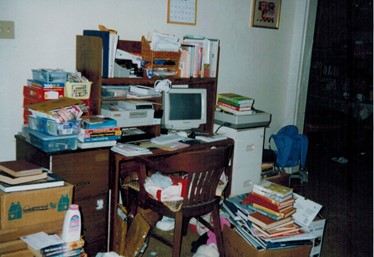
Seven Steps to Clutter Control
A March 2012 article in Psychology Today cites several reasons why messy homes cause higher levels of stress hormones in our bodies. Clutter bombards our minds with excessive stimuli, distracts us, makes it difficult to relax, and causes anxiety and feelings of guilt and embarrassment.
For many years as I raised young children, I was too embarrassed to invite anyone into my home. A 1996 photograph of my desk shows a completely filled desktop and drawers crammed with pens, pencils, scissors, notepads, and reams of computer paper. Stacks of coupon inserts lay waiting to be clipped, lists of books I sold through the mail ready to be folded and stuffed into envelopes.

Surrounding the desk were boxes of books ready to be priced, a canister of baby powder perched precariously atop a stack of packages waiting for a post office trip. The baby carrier on the floor revealed the reality of my juggling act as a homeschooling mother, writer, and home business operator. Books were a staple in our household, filling several shelves and piled on end tables. Art materials and educational toys filled baskets and bins in every corner of the house. My home reflected that season of my life: busy and messy.
Clutter Collection
As my eight children grew older, the type of clutter changed, but my thrift store retail therapy habit and book and paper addictions meant the physical space I inhabited was hardly conducive to creativity or productivity.
Though I somehow managed to crank out articles and essays for publication, there’s no denying my messy house constantly signaled to my brain that my work was never done, a familiar refrain from women in general, but especially those with small children.
I’m not surprised a March 2014 Los Angeles Times article claims the average U.S. household contains 300,000 objects. Counting paper clips and pennies, I’m sure my four-bedroom, two-story home contained even more than that. Facing an upcoming move with my youngest daughter in the spring of 2018 was the ideal time to streamline my possessions, putting into practice advice I’d garnered from decluttering guru Marie Kondo, who advises readers of her book Spark Joy to discard everything in their house that doesn’t bring joy. It was going to be impossible to fit all the “stuff” I’d accumulated into a house with less than 760-square feet, so I had to be brutal in the downsizing!
I began with my home office, following Kondo’s advice to touch each item, asking myself if it brought me joy or would fit in my smaller space. Did I really need two vintage blue Royal typewriters for display, or was one enough? What about wooden chess and checker sets that for the previous ten years had hung on the wall gathering dust? My huge oak desk had to go, and my desktop computer with it. I sold two solid oak bookshelves, weeding my book collection from over a thousand books to those that would fit in the top two shelves of the vintage cabinet I was determined to take with me. In a purging frenzy, I disposed of half of everything I owned, holding two garage sales and carting leftovers to the local thrift shop.
Spring Cleaning
Though few of us will require halving our personal possessions in the quest for decluttering, spring is the perfect time to address the mess in our homes. Scientific research demonstrates that decluttering and surrounding ourselves with beauty contributes to our happiness and creativity. Here are seven helpful tips to get you started:
- Start small. Attempting to organize an entire house can feel overwhelming. Consider tackling big jobs in phases. Make a list of areas in your home you want organized, from the junk drawer in the kitchen to the more daunting projects of attic or garage. Checking a small project off your list gives you a sense of accomplishment that will encourage you to keep going.
- Allow just twenty minutes a day for organizing. Maybe you don’t have two hours to devote to the garage, but if you devote just twenty minutes to the project each day, in a week’s time you should see some progress. You might find that once you get started, you don’t want to stop after twenty minutes. You may even discover “found” time, like the two hours you’d typically spend in front of the television at night.
- Sort into two piles: one for things to donate or sell, and one for throwing away. If this major overhaul includes furniture or other large items, you might want to host a garage sale (Top 10 Hints for Holding a Successful Garage Sale – Familius.com Shop) or take things to a resale shop. Consider donating your excess to a Goodwill or other thrift store that supports a cause. While it’s said that one man’s trash might be someone else’s treasure, please don’t donate items like old underwear or broken appliances. Thrift stores are not your personal landfill.
- Purge wisely. It’s easy to get in the mindset that everything you own is of equal importance, but if you haven’t used something in the last two years, there’s a good chance you don’t need it. This is especially true as you organize your closet space. If you haven’t worn something for five years, you probably never will. When I helped my fiancé, Nick, sort through his closets before our wedding, I discovered shorts that had deteriorated to the point the elastic in the waist cracked when stretched! Not all old clothing went into the trash, however; we made the decision to keep his Army jacket and most of his baseball cap collection, with the intention of someday displaying them.
- Take your time as you sort through the sentimental. It’s easier to part with clothing you haven’t worn since the ’80s than it is your baby’s first outfit or letters you inherited from your mother. Don’t rush the process. I have only one regret in regard to my downsizing and it is getting rid of twenty years of daybook diaries. I wish I had taken the time to look through them, but I only had two months to prepare for my big move. If I’d taken my time, I might have torn out pages or notations that might have been incorporated into a collage or scrapboook. That said if your pieces of memorabilia are stuck inside a trunk or storage shed, what’s the point of hanging onto them? You aren’t enjoying memories if they are hidden away.
- Surround yourself with beauty and meaningful things that make you happy. Like the collage of my mother’s things or our display of childhood memorabilia, there are certain things that decorate my home that bring me great joy: artwork created by my mother or daughters, a book-themed lamp, wooden carvings from my mother and brother, and cozy pillows and throws. Even the red appliances and utensils on my kitchen counter bring a smile to my face when I look at them.
- For every item you bring into your house, get rid of another. It’s one thing to get organized; it’s another to stay that way! Despite having downsized my book collection, a year after my move I’d somehow managed to accumulate even more books. Lacking shelf space, towering stacks of books piled up next to my recliner. Facing yet another move, I went through the stacks, discovering there were few I wanted to keep enough that were worth packing. I could always borrow others from the library. To prevent this from happening in the future, I’ve vowed that whenever I bring something into our home, something else goes out
If an organized home is key to managing stress, now is the time to address the mess. Happy spring cleaning!
Mary Potter Kenyon graduated from the University of Northern Iowa with a BA in Psychology, and is a certified grief counselor. She is the Program Coordinator for the Shalom Spirituality Center in Dubuque, Iowa. Mary is widely published in magazines, newspapers, and anthologies, including ten Chicken Soup books. Her essay on the connection between grief and creativity was published in the January/February 2013 issue of “Poets & Writers” magazine. Mary conducts writing workshops and does public speaking on the topics of writing, utilizing your creativity in your everyday life, and finding hope and healing in grief.
She had been a keynote speaker at the Iowa City Book Festival, Galena Lit-Fest, St. Thomas More Church in Coralville and the American Martyrs Retreat House in Cedar Falls. She has taught writing workshops at Hawkeye Community College in Cedar Falls, NICC, libraries, and annually at the Cedar Falls Christian Writer’s conference every June since 2012. She is the author of Coupon Crazy: The Science, the Savings, and the Stories Behind America’s Extreme Obsession, Chemo-Therapist: How Cancer Cured a Marriage, the award-winning Refined By Fire: A Journey of Grief and Grace, Mary & Me: A Lasting Link Through Ink, co-written with Mary Jedlicka Humston and Expressive Writing for Healing. Her book on creativity, Called to Be Creative, was released in August 2020.
